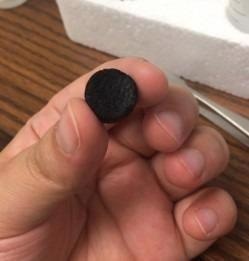AZoM speaks with Professor Guihua Yu from the University of Texas at Austin about a novel hydrogel tablet that is capable of rapidly converting contaminated water into purified drinking water. This novel process can potentially make a big difference in mitigating global water scarcity.
What inspired your research into developing a new way to quickly purify river water?
The water crisis is the number one global risk based on its impact on society, and consumption of unsafe water is a major cause of morbidity and mortality. Every 90 seconds, a child dies from a water-related disease. So there is a strong demand for simpler approaches and innovative materials to disinfect water.
Clean water has long been an international goal. How can this multifunctional hydrogel make a big difference in mitigating global water scarcity?
Hydrogels have unique interactions with water molecules. By modifying hydrogels at the molecular scale, they can be integrated with desired functions to target contaminants in water. Plus, most of the hydrogels we developed are from low-cost raw materials with decent processability for scaling. Hydrogels are definitely an emerging materials platform for water purifications.
Can you provide an overview of how this novel hydrogel tablet rapidly converts contaminated water into purified water?
Our hydrogel tablets consist of a catechol-functionalized chitosan skeleton and quinone-anchored activated carbon particles. The catechol-functionalized skeleton can spontaneously release hydrogen peroxide, a green chemical disinfectant, to kill bacteria. In addition, quinone-modified activated carbon particles speed up and enhance the bacteria-killing efficiency by disrupting the essential metabolization process of bacteria. After disinfection, the tablets are simply removed, leaving no chemical impurities behind in the water.

The hydrogel tablet developed by scientists and engineers at The University of Texas at Austin. Image Credit: The University of Texas at Austin

Using the hydrogel tablet to purify water. Image Credit: The University of Texas at Austin
In your research, you mention other water purification methods, including water disinfection using chemicals, thermal-based water treatments and other physical water purification technologies such as membrane filtration and solar assisted distillation. What are the limitations of these methods?
Thermal processes, such as vapor compression and multiple-effect distillation, are enticing, but they require significant infrastructure, incorporating energy-on-energy recycling to make them competitive with reverse osmosis. Reverse osmosis technologies that use membranes to purify water have several limitations, including high cost, energy inefficiency, potential fouling and significant wastewater discharge.
How does your hydrogel tablet overcome the current challenges in water treatment technologies?
Our developed hydrogels barely need any energy to function. They can be used in two ways: first, using them as disinfection tablets, for which no energy (electricity) is required. You only need to drop the tablets into bacteria-containing water. Our hydrogels will not bring disinfection by-products (DBPs), and they are suitable for long-term use. According to CDC.gov, humans exposed to large amounts of DBPs could experience liver damage, bladder cancer, miscarriage, birth defects and decreased nervous system activity. The second way is to use it as a solar evaporator with a simple distillation setup. In this case, distilled water can be collected, using sunlight as the only energy input.
Did you come across any challenges during your research, and if so, how did you resolve them?
The initial design took a lot of time since we wanted to make biocompatible hydrogels (chitosan) that had anti-biofouling properties. In addition, the source of bacteria was hard to find. Luckily, we had our collaborators in chemical engineering to help and support us. Teamwork was very important when it came to achieving our goal.
Aside from water purification, what else can these hydrogels be used for?
Hydrogels are commonly used throughout our daily life in items such as baby diapers, soft contact lenses and solid air fresheners. Conventional hydrogels have been used a lot in tissue engineering, drug delivery and other biomedical applications due to their stimuli responsiveness and excellent biocompatibility. Our group focused on using hydrogels for energy and water-related applications, including batteries, supercapacitors, atmospheric water harvesting, etc.
How can this hydrogel tablet improve the lives of people in developing nations who do not necessarily have access to clean water?
As previously mentioned, our hydrogels do not require much energy/electricity, which greatly benefits off-grid communities. The low cost of their raw materials also makes them attractive for people living in developing areas.
What does the future of water purification look like to you?
It might take a few years to commercialize a product from research, but we believe the broader impact of hydrogel materials in the energy-water nexus is expected to become increasingly important in the years to come.
What are the next steps for your research?
We are currently testing the capability of our hydrogels to kill more kinds of pathogens in water. Other heavy metal ions and organic contaminants will also be considered in the future. Meanwhile, we are also conducting more thorough water quality tests and working with UT Energy Institute to promote commercialization with more prototypes.
About Professor Guihua Yu
 Professor Guihua Yu is currently with the Materials Science and Engineering and Mechanical Engineering department at The University of Texas at Austin. His research interests include the synthesis and self-assembly of nanoarchitected polymeric materials and hybrid organic-inorganic nanomaterials, fundamental understanding of their chemical and physical properties and exploration of their technologically important applications in energy, environment and sustainability.
Professor Guihua Yu is currently with the Materials Science and Engineering and Mechanical Engineering department at The University of Texas at Austin. His research interests include the synthesis and self-assembly of nanoarchitected polymeric materials and hybrid organic-inorganic nanomaterials, fundamental understanding of their chemical and physical properties and exploration of their technologically important applications in energy, environment and sustainability.
He received numerous awards, such as Blavatnik National Awards Honoree, 2021, Edith and Peter O'Donnell Award in Engineering, The Academy of Medicine, Engineering & Science of Texas (TAMEST), 2021, IAAM Medal Award, 2021, Polymer International - IUPAC Award for Creativity in Applied Polymer Science, 2020, etc.
He is a Fellow of the Royal Society of Chemistry and Institute of Physics, Sloan Research Fellow and Camille Dreyfus Teacher-Scholar. He serves as an Associate Editor of ACS Materials Letters.
Disclaimer: The views expressed here are those of the interviewee and do not necessarily represent the views of AZoM.com Limited (T/A) AZoNetwork, the owner and operator of this website. This disclaimer forms part of the Terms and Conditions of use of this website.